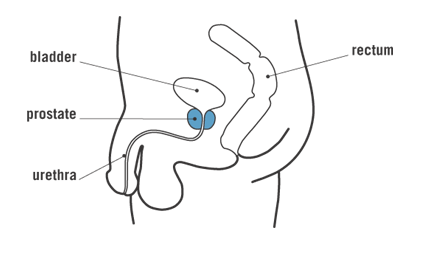 Brain Teaser #5
Brain Teaser #5
A) Question:
In relationship to the bladder, the prostate usually lies where anatomically?
A) Answer:
The prostate usually lies slightly posterior and inferior of the bladder.
B) Question:
When treating the prostate what is the MOST critical structure?
B) Answer:
Rectum is the most critical structure when treating the prostate.
C) Question:
The TD5/5 for the whole rectum is?
C) Answer:
The TD5/5 for the whole rectum is 6,000 cGy.
D) Question:
In relationship to the prostate, the rectum usually lies where anatomically?
D) Answer:
The rectum usually lies posterior of the prostate.
Follow Up:
Hopefully this digram will help.

E) Question:
Under normal circumstances, what is the range for a normal PSA? (for this question assume the range that is MOST widely accepted by physicians).
E) Answer:
Usually a normal PSA range os 0 - 4 ng/ml
Follow Up:
It is important to keep in mind this is usually the "normal" range. There are many things that can affect PSA levels. Processes that may elevate PSA in the blood include, but are not limited to, benign prostatic hyperplasia (BPH), prostate cancer, prostate infection, and a prostate biopsy.
F) Question:
You are doing IMRT on a prostate patient. The total MU's delivered for field one is 224 MU. The total dose given is 40 cGy to central axis, what is your dose per MU at central axis?
F) Answer:
The dose per MU would be .179 cGy/MU at central axis.
Follow Up:
Simply take your dose, and dived it by the monitor units. This will give you dose/MU.
------------------------------------------------- = dose/MU
MU
so,
40 cGy
------------------------------------------------- = .179 cGy/MU
224 MU
G) Question:
You get a little way through the IMRT treatment and the machine shuts off. You are on field one, and this is the only field you have given treatment with. You cannot restart the machine. You gave only 86 MU out of the 224 MU, what dose did you deliver for that day to central axis only?
G) Answer:
You would have delivered 15.4 cGy to central axis.
Follow Up:
You can do this problem two ways. You can set up a proportion or use the factor from the last question.
First the proportion:
--------- = ---------
224 MU 40 cGy
x= 15.4 cGy
or,
From the last question we know that we have a factor of .179 cGy/MU, so if only 86 MU were delivered you can figure out what dose was given. Simply take your factor .179 cGy/MU and multiply it by 86 MU. You will see that you will get the same answer.
X=15.4 cGy
H) Question:
If 40 cGy was suppose to be delivered to central axis, and only 15.4 cGy was actually delivered, how much dose didn't get delivered to central axis?
H) Answer:
24.6 cGy didn't get delivered to central axis from that field.
Follow Up:
40 cGy minus 15.4 cGy will give you the dose not delivered to central axis for that one field.
40 cGy - 15.4 cGy= x (dose not delivered to central axis)
x= 24.6 cGy
I) Question:
If 40 cGy was suppose to be delivered and only 15.4 cGy got delivered, what percent of dose didn't get delivered to central axis?
I) Answer:
61.5 % of the dose didn't get delivered.
Follow Up:
Simply set up a proportion.
--------- = ---------
100% X
THE END
Author: Adam Buell
Editors: Mary Hare
Date Created: April 2005


